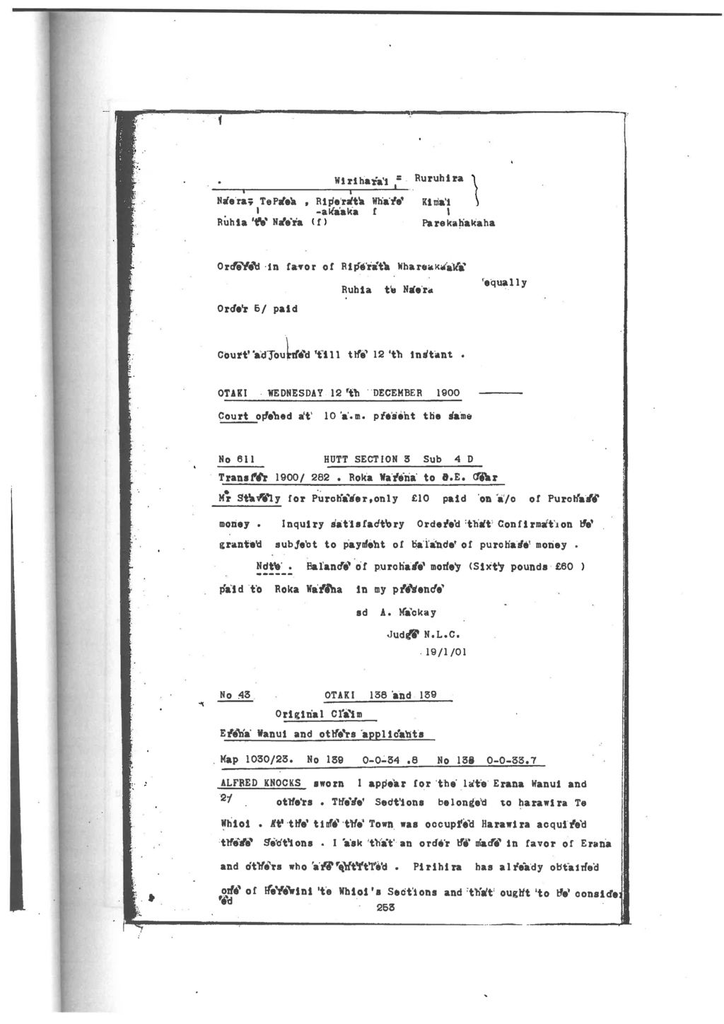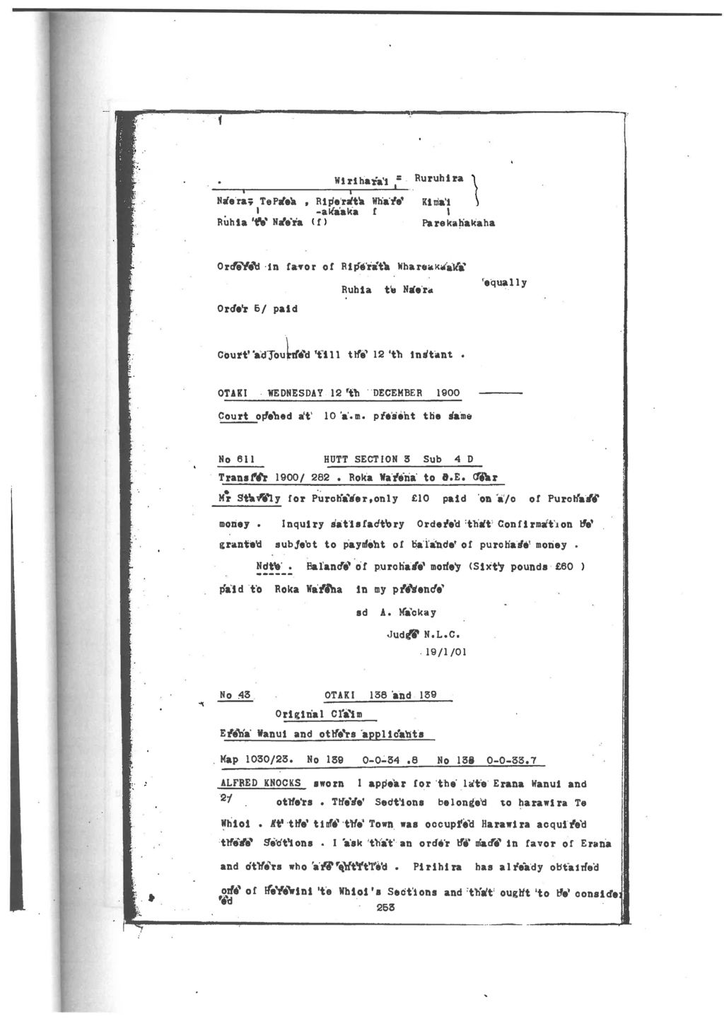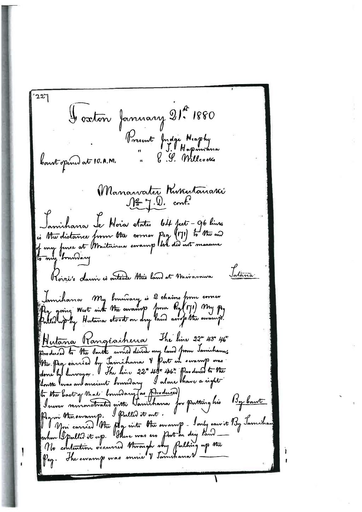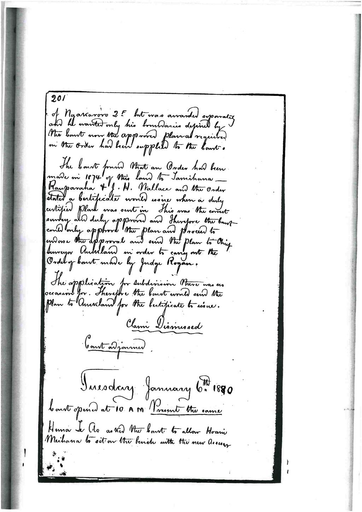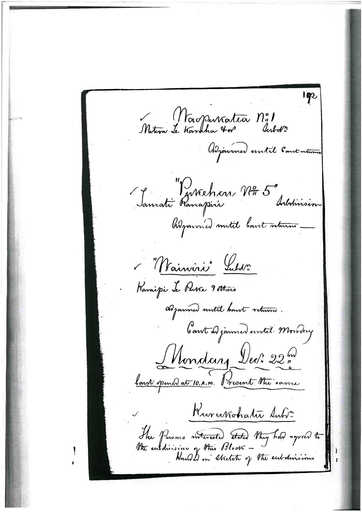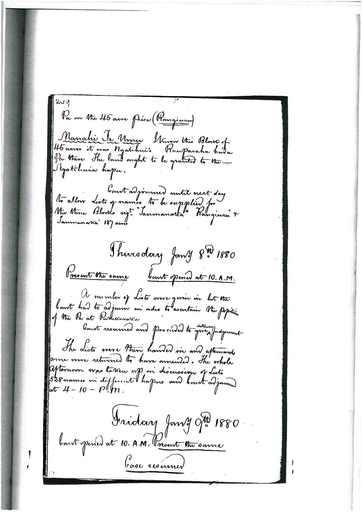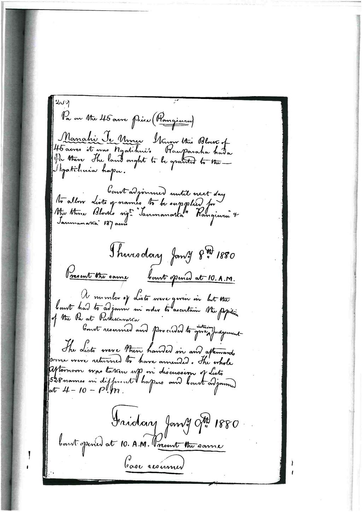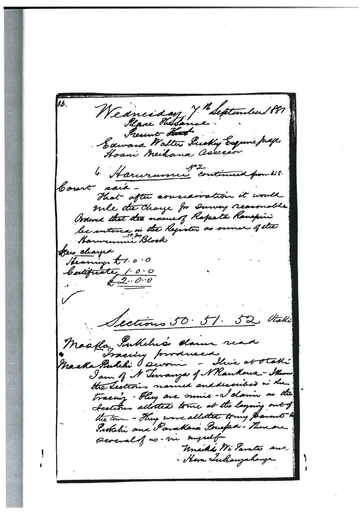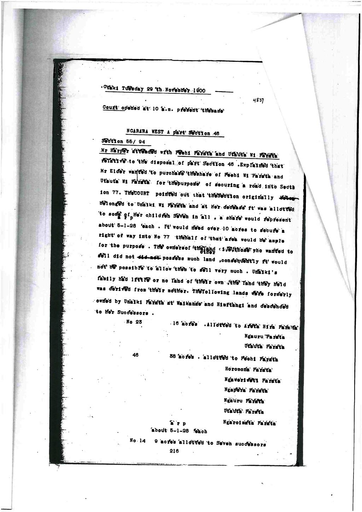Otaki Maori Land Court Minutebook - 12 December 1900.
- Description
Thursday 12th December 1878
Court opened at 10 am.
Present – the same
Turangarahui – continued
Tamihana Te Hoia – sworn
I belong to Ngati Huia and live at Porotawhao and Otaki.
I know the land as shown on the land it is 365 acres and belongs to Ngati Huia. I know all the boundaries I conducted the survey.
When Ngati Raukawa first came here the land was Rangihaeata’s Ngati Huia his hapu when they came all this was allotted to them they lived on it and cultivated it.
There are cultivations of Ngati Huia on the land known as Turangarahui there were others on the Otaki but which were washed away. My parents cultivated it. No one opposed except Ngati Turanga.
Ngati Huia had always undisturbed possession the resident portion of Ngati Huia who lived on the land are entitled.
My father Te Hoia and family I admit Hapi Rangitewhata and his family, Hutana and Kiriona, Karanama Te Kapukai, Metara Karaha and family, Nepia Te Rau, Mikara Manahi Te Umu, and Hohaia Te Paha.
We are still in undisturbed possession. The hapu who I have said opposed viz Ngati Turanga all live at Manawatu. No money or anything has been taken by us on account of this land from government.
Objectors challenged
Rawiri Roto appeared for Ngati Maiotaki.
Hema Te Ao appeared for Ngati Ngarangi, Ngati Rakau, Ngati Turanga, and Ngati Rongo.
Eruera appeared for Ngati Kiri who only claimed Ringawhati a trespass boundary.
Case of Ngati Turanga
Pineaha Mahauariki – sworn
I live at Wairarapa.
I have heard Tamihana’s statement and I object to it.
I know the land as shown on the plan. The clearing in the bush mentioned by Tamihana belongs to us. It was a natural clearing we cultivated it before Haowhenua was fought we stayed on the land and my people before I was born. We carried our cultivations all over the block when we commenced working the great pa of Ngati Raukawa was at Otaki and the cultivations were at Maringiawai, Katihiku, Takapu, Ngati Turanga, Ngati Toa, Ngati Rakau cultivated at Takapu all this land was then forest.
The chiefs of these tribes came to divide off land they came to this open place Te Raotea remained there Rangihewea went and settled on a piece further on. Kohetu and Whatuai’s on another part they divided off the land and in the evening returned.
Next morning Raotea returned with his wives to the clearing and settled there, he also built a house his work was collecting karaka’s he cleared a portion of the bush they steeped their karaka in the Rahui and when finished returned to the pa.
Rangihaeata heard that this clearing had been discovered. He brought his slaves and Ngati Huia and went up the Otaki in his canoes and came to this place and saw his house and the stream here they steeped their karaka. They burnt the houses and took the karaka’s. When he came out the other hapu’s heard that their houses had been burnt.
All the chiefs of Ngati Raukawa heard of this and Rauparaha and Rangihaeata all the hapu’s assembled at this place. Rauparaha, Rangihaeata were on the side of Ngati Huia and the others on the side of the other tribes.
Ngati Huia were in possession and Raukawa and the others wished to dispossess them. Each party began to clear the bush at midday Ngati Huia left it and gave way.
I have heard all this from my ancestors. Ngati Huia left this land altogether. The other hapu’s went on working. Ngati Huia’s right ceased that day when they left.
We do not claim the south east portion but we claim all on the western side from that time we have had undisturbed possession we have a cultivation on the Rahui Stream. I was born on this longer after crops had been raised on this land. After that was the fight at Haowhenua.
Ngati Huia was not on this land at that time when the peace was made the hapu’s became divided some went to Manawatu and others went on this land and remained there.
My father and family stayed there. During my own time I have never heard of anyone coming to oppose us. We put others on this land besides ourselves.
Ngati Rarangi was put on it after Haowhenua at the time of Kuititanga fight they built houses and stayed there until recent times. Ngati Huia never came to interrupt us in any way. The site of the mill is on the Rahui Stream on the outside of the boundary the arrangement about the water for the mill were made with us and not with Ngati Huia they made no objection when the water course was cut from the Rahui Stream.
A year after Kuititanga fight I came to know the cultivation belonging to us on this land and I can now speak of my own knowledge.
Rngiuru was Ngati Raukawa’s pa at this time and the cultivations of my family were on this piece of land.
I first knew the land in 1845 it was the year when Otaki was settled on. 1846 all the people came here to live. Our cultivations remained there as ours till 1871 the person who was in charge died.
My brother was the person who had charge my sisters are alive and remained on the land they have fences and sheep. There were other persons sheep there trespassing. I drove them off.
I did not stay long on the land I went to Wairarapa the sheep belonged to Peene Arama.
The part to the south east belongs to Ngati Kiri it has been before the Native Land Court as Waihoanga No. 2.
Ngati Huia applied to have Rahui Te Ringawhati and Waihoanga heard before the court and they stated their title to the lands and they failed in April 1874 you will see the evidence in the records.
I am about 44 years old and have lived nearly all my life on this land and I consider that anyone who lives the longest in possession is the person entitled.
Between the Rahui Stream and Otaki River was a piece of land which belonged to Ngati Huia. I saw two cultivations of the Ngati Huia, Te Riaki, Pene Te Aunui are their names.
Hoani Taipua owns the portion of the western awn of this block Otaki River.
Riaki cultivated on the south side of the Rahui Stream and we on the north. I used to take him food. These two came and settled when I was a young man.
The northern boundary as shown on the plan is an ancient boundary between us and Ngati Maiotaki that is, as far as a peg and beyond that to the north point of Rahui claim belongs to Ngati Kiri and others. The part at the western extremely belongs to us.
The part which is marked from a peg in a straight line to the bush to the north on the outskirts of the clearing thence in a westerly direction until it meets the Rahui Stream thence by that stream till it meets the survey line and from thence a crop in a straight line to the Otaki River following that river (excluding a portion on the said river belonging to Hoani Taipua) to the starting point belongs to Ngati Huia.
The line south east of our claim was laid off Arama Karaka, Poriao, Hapita and ourselves.
Rawiri and others applied to my parents to allow them a cultivation for Kumera’s in the clearing, they had two and remained two years. Ngati Huia never made any objection.
We have houses outside the land. All the people knew of our claim to this land.
By Dr Buller
My permanent settlement is Manawatu.
After Haowhenua some of our people went away and others stayed. My parents stayed, Raoatea Rangiheua and Apera Te Pahu. They went to Manawatu at the time of Haowhenua. Some of their relations stayed at Otaki but they lived and died at Manawatu. Takapu and Maringiawai are outside this block.
My parents and I worked on the land I have a cultivation of my own on the north side of the Rahui Stream.
I only saw two of Ngati Huia cultivations there. Their descendants are living. Te Rau succeeds Riaki, Te Rau is father to Nepia Te Rau one of the claimants. I cannot say if Pene Te Ao---- representatives are living, Katihiku belonged to Ngati Raukawa. Ngati Huia proved their title to it when it went through the court.
Our cultivations were before Haowhenua and we have done so ever since up to the present.
Ngati Rarangi lived principally at Manawatu. I never heard that Rangihaeata determined all these boundaries. I only heard that ----- and Kohata divided the land Te Rauatea after Haowhenua went to Manawatu and lived there to the time of his death.
When Rangihaeata came with his slaves Rauatea was still on the land. They had a difference about this land and Rauatea left and never came back. His grandchildren remained on the land. I am one of them not an actual grandchild but a relation. I was born at a cultivation close to the Maire. My elders showed me the place before ever a line was cut that boundary line was afterwards cut by Hare Wirikake with my consent.
Ngati Huia did not come with Rangihaeata as slaves they came as supporters of his.
Rangihaeata did not go himself he sent his slaves with Ngati Huia he gave the land, I think, to Ngati Huia. Ngati Huia came as chiefs and settled on the western portion as I have heard. They are the same as those spoken of by Tamihana Te Hoia. Te Raotea’s cultivations and karaka pits were before Haowhenua but when Ngati Huai went on this land by direction of Rangihaeata they opposed Raotea and resulted in a division the Ngati Huia going on the south and we on north.
Court adjourned until 2 pm.
Resumed at 2 pm.
Xed by Dr Buller
Pineaha – continued
Originally the land belonged to Muaupoko and then came a dispute between Ngati Raukawa and Ngati Huia but the mana remained with the old people who went to Manawatu and whose names I have mentioned Te Raoatea was the first who went to that opening in the bush.
After this dispute the clearing was found the hapu’s I have mentioned stayed permanently on it.
Ngati Raukawa came under the mana of Rangihaeata and Ngati Toa. Rangihaeata and Ngati Toa are the same. Rangihaeta and Rauparaha and Ngati Huia were on one side and Ngati Turanga on the other, Whatanui, Matia, Kiaroa Nepia Taratoa, Ngakuku, Hanita, Te Ahoaho, Matangi Te Puke – these were Raukawa who supported Ngati Turanga.
Natana with his tribe stayed here he went to Muhunoa (north) he died there and his remains were brought back and buried Nepia Taratoa’s tribe was Ngati Parewahawaha who occupied northwards from Ohau and Rangitikei where he died.
Matia’s tribe was Ngati Pare. They lived at several places about Otaki.
Kiharoa belonged to Ngati Pare Matiaua also belonged to Raukawa. They lived at Ohau.
Hanita’s hapu was Ngati Whaihuria they occupied round about Otaki Town.
Te Ahoaho belonged to Ngati Maiotaki the owners. Matangi belonged to the same hapu and Te Puke to Ngati Pare. I do not know whether Te Puke is.
When I sai Ngati Huia only worked a day it ended in a dispute and they going to the other side of the Rahui my elders remained on the land Te Raoate, Te Kuru, Aporo Te Pahu, Te Kahi Paru, Rangiheuea, Rangitukia are their names they were all Ngati Turanga.
Those belonging to Ngati Rarongo are Whatuaio Te Koheto and others I don’t know.
Te Raratea went to Manawatu and died there, Te Kuru was the father to Petihera Te Kura one of the counter claimants in this case he also went to Manawatu and died there. Aporo Te Pahu also went there and died. Aho takuhi Paru, rangiheua is father of Roere and of my mother. He also died there my mother is still living she lives at Himatangi.
Tukea died at Rahui on 1866.
The migration of the people from here was after Haowhenua they returned here and after the fight at Kuititanga they went away to Manawatu and remained there. They went to Himatangi then (in 1839) and remained there ever since. I don’t know exactly what Rangi Tukea’s relationship was to me but he was one of my old relations he died outside the block a permanent residence of ours which has not been included in the survey. He left no children.
I was born, bred up and lived constantly on the land about 2 years since I was ordained and went away to Wairarapa. I am related to Ngati Huia. My father died in Otaki but my fathers’ cultivation was on this block hence the claim of all my family including those who went to Himatangi. My mother and younger sister stayed here. My mother went away to Himatangi afterwards and her younger sister remained. All my family claim in Himatangi (11,000) through these old people I have mentioned who proved their title through the Native Land Court.
Te Koheto and Whatuaio representing Ngati Rongo died at Manawatu. These two went away after Haowhenua and permanently lived at Manawatu after Kuititanga Ngati Rarangi stayed here until the old people died off but their descendants are living about here still and the Ngati Huia always lived on friendly terms with all Ngati Raukawa and Ngati Huia worked at the mill but the granting of the water course was ours.
Ngati Raukawa asked us, I cannot say who made it. My mother and her sister were the persons whom they asked for the consent and then myself and not by all Ngati Raukawa.
Kiharoa my elder brother lived outside the boundary he died at Manawatu in 1872. This northern boundary was determined between Raukawa and myself. I do not follow your boundary any further but branch off to the apex of Rahui block.
Ngati Kiri lives in Otaki Town. Ngati Kiri sold the south eastern part to government and they gave up living there. I don’t know Ngati Kiri chiefs it’s for them to say whether they sold it or not. Ngati Kiri and myself arranged the boundary between us which I now describe Teariki, Pene and Taonui died at Otaki. The southern boundary from the corner running westerly was laid off by Hari Wirikake who was married to Kararaina Whawha. I don’t know her hapu he belonged to Manawatu and here.
The extreme portion to the west was cultivated by Waharahi a slave of mine who I don’t propose to put in it belongs to myself my mother and her sister. There are others who I don’t know.
I don’t claim a crop the Otaki River. I fixed the western boundary of the piece between Ngati Huia and myself they were no parties to it.
Ringawhati is sold to government it is between Ngati Kiri and Ngati Raukawa. In fixing the boundary for the sale it was done by Ngati Kiri and no I don’t know that Ngati Huia had anything to do with it.
All the old chiefs of Ngati Kiri are all dead.
Hoani Taipua claims through his father who belonged to Ngati Pare.
Our fence is outside the block but it is intended to fence in the North West side of the block.
Rawiri asked permission for himself to cultivate. K--- was not a Ngati Huia he was a Ngati Raukawa.
Xed by Rawiri
I heard that Ngati Maiotaki and Ngati Tekopere laid off the boundary eastern one of Rahui. Ngati Huia also laid off a boundary which came up to ours.
When Waiohanga went through the court the boundary came to that line Ngati Huia came forward and objected to the boundary at the court in 1874. The court decided in your favour of Ngati Kiri and Ngati Maiotaki.
Roere Rangihewea – sworn
I live at Manawatu and Otaki and belong to Ngati Turanga.
I know the clearing at Rahui. I know the spare between the Rahui stream and the survey line. This clearing including the narrow strip belongs to Rangihewea, Raoatea, Te Meti, the hapu’s are Ngati Rakau, Ngati Turanga, Ngati Toa, Ngati Rongo’s was laid off the line extending on southerly direction I remain on one side and Hari Wirikake on the other.
I have cultivated all over the portion I have described. The cultivation in the clearing was first worked by us. I know the one close to Wirikake’s boundary. The cultivation that Ngati Huia interfered with was in the clearing. Their interference was of no avail. They went away from there to Katihiku and settled there. I did not see them return.
I did not see Hohaia and others cultivating on the land his principal place of abode is Porotawhao. I never saw Hapi cultivating there.
I know of no cultivation of Tamihana’s on this clearing. I never saw one or yet Kiriona.
I have a cultivation on this land when I have been living at Manawatu I still have been too and from on to this land. When Otaki was laid out that was the time I went away. I have since returned.
Kih--- house stood outside the block at the place where the survey crops the Rahui stream. His fence takes in the line which runs near the Rahui ---- ----- portion belongs to me and my relations. The clearing is fenced in it has been fenced twice. Kiharoa fenced it once, Hema and Hoani Taipua.
The northern boundary is an old boundary Ngati Huia is trying to get this land in spite of the boundary laid down by Ngati Raukawa and ourselves.
When the line which runs nearly down the centre, remains with Ngati Kiri and Ngati Rarangi. Rahui block belongs to Ururoa his younger brother consented to our boundary we took in a cultivation of his. Ururoa’s hapu is Ngati Kikopiri. I don’t know if they are connected with Ngati Huia.
Xed by Dr Buller
Rangihewa was my father he died at Manawatu he had been subdividing land ---- some time after Kuititanga he went to Manawatu and died there. He was born at Turakina at the great coming of Ngati Raukawa at the time of Haowhenua he went to Manawatu and stayed there two years after Kuititanga he used to visit this place.
I have stayed here principally. It is 15 years ago since I went to stay permanently.
I know Himatangi block it belongs to 3 hapu’s and contains 11,000 acres it belongs to 3 small hapu’s of Raukawa exclusively they own land here and Maungatautari.
Arona isww a relative of mine. Patukohuru is the same tribe their permanent settlement is Manawatu. This is another place of theirs.
They made good their title to the Awahou and sold to the government. They now live on both sides of the Manawatu River. Arona is half Ngati Turanga and half the other. For 4 years when Otaki town was laid out I cultivated in the angle outside this block on the west and also on Pineaha’s west corner. I have only heard in the dispute of Ngati Huia.
I have seen Hohaia in Otaki but he went away from here the same as we.
Katihiku is Ngati Huia’s permanent settlement also Porotawhao. It was long after the Kuititanga that the Otaki Township was laid out. I commenced cultivating. The fence was outside the block but it closed up the opening keeping on the land included in this plan.
Pineaha and myself have the same claim.
Court adjourned at 5 pm.
Identification
Taxonomy
- Community Tags

